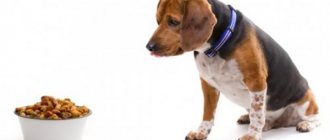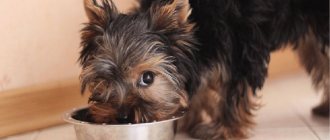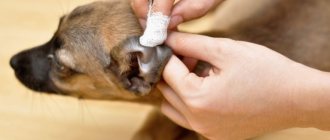General principles of feeding
Before feeding your dog natural food, you need to familiarize yourself with the basic principles of formulating diets, depending on the breed, age, and condition of the pet. Not all owners are ready to devote a lot of time and attention to menu creation. Without this, such food can become harmful and even dangerous.
What should the diet consist of?
It is necessary to think in advance about the diet for adult dogs and puppies. Natural food for dogs should include the following products:
- Meat. It is not necessary to cook meat or offal, as they can be given to animals raw.
- Vitamin complexes. Must be included in the diet of purebred dogs and ordinary mongrels.
- Fermented milk products. These foods should be included in your dog's daily menu.
- Vegetables. They are given along with vitamin complexes. At the same time, you need to feed the dogs vegetables, grated on a fine grater.
- Cereals. They must first be boiled and only then given to the pet.
Important! Only meat products that have been frozen in the freezer for at least three days can be given raw.
Product percentage
Meat is the basis of any dog’s diet
Before thinking through a menu with natural food for dogs, you need to understand the optimal ratio of products.
The basis of the diet of any dog, regardless of breed, should be meat. At the same time, it is necessary to ensure that for each kilogram of weight there is no more than 30 grams of meat products. Based on this, a dog weighing 15-20 kilograms should eat 350-400 grams of meat daily.
Important! If by-products are used instead of meat products, they will have to be given twice as much.
In percentage terms, natural dog food is as follows:
- 50% meat products or offal;
- 20% cooked cereals;
- 20% fermented milk products;
- 10% vegetables with fruits.
It is allowed to give lean sea fish instead of meat once a week.
Good puppy feeding: basic points
When choosing the type of dog food (dry food or natural food), follow the rule - do not overfeed! Overeating can have serious consequences. It’s not worth growing your pet’s stomach to a large size; overfeeding will lead to poor health, joint problems, which is especially important for large breed dogs), and diseases of the internal organs.
When can you feed puppies? Before bedtime, if the dog is hungry. Offer your pet milk porridge, pamper it with meat, but do not make the ritual daily.
Feeding the puppy natural food
Many owners choose how to feed their dogs natural products. The reasons for choosing are as follows:
- natural food is cheaper than buying ready-made food;
- natural food gives confidence in the quality of food.
There are also a lot of disadvantages to feeding “human” food: you have to often go to the store and prepare food, because during the growth period the animal eats a lot.
The main motto is “Only natural”, isn’t the prospect of standing near the stove for a long time scary? We recommend paying attention to the freshness of the products. Meat that tastes good at a low price will play a cruel joke on the health of an eared baby. Poisoning from low-quality products is not uncommon. Remember that a puppy is a small child, so it is important to take food responsibly.
Second rule: you cannot feed your dog from the table! Signature aromatic borscht, seasoned with sour cream, cabbage rolls prepared according to a family recipe will appeal to people, but not to the puppy, and will cause problems with his well-being!
What can you feed your little friend?
1) Milk
A puppy's diet up to 4 months includes milk. This product provides vital elements for the growth and development of a foolish baby. Offer it raw and cook milk porridge. Not every milk will do. Choose goat, you can’t go wrong - there are rarely allergies to it, and it is easier to accept by the body. Having trouble finding a goat? You can give cow's milk, but dilute it with water to avoid intestinal upset.
Closer to six months, the amount of milk is reduced and gradually eliminated, replacing it with fermented milk products.
2) Dairy products
Proper feeding of puppies consists of many factors, including fermented milk. Good digestion and enrichment of the body with calcium are a wonderful reason to buy your pet cottage cheese, kefir, and low-fat sour cream. Whey is one of the most useful products, containing a huge amount of useful substances. According to the degree of usefulness, hard cheeses are distinguished, which are easy to use as a reward during training.
3) Meat
It must be present in the daily menu, at least 40% of the total diet. You can give raw, frozen, boiled, scalded meat. The priority is still given to raw meat, because the predator is being raised. What species can be included in a puppy's diet?
- skinless chicken;
- turkey;
- veal;
- beef;
- horsemeat;
- offal (cooked, raw).
The meat is given, cut into cubes, but not minced.
4) Fish and seafood
Offer it to your puppy twice a week. Give preference to sea fish (river fish is often hazardous to health): squid, shrimp, mackerel, hake, pollock. Do not mix with meat feedings.
5) Vegetables
Teach your baby to vegetables: they contain many vitamins. Mix with cottage cheese, porridge, grind on a fine grater, serve as a puree or simmer - and you have delicious dishes that are easily digestible. Pumpkin, carrots, zucchini, beets, and greens (onions, parsley, spinach) are useful.
6) Berries, fruits
Undoubtedly, they are useful, so feel free to include them in the diet, especially if your dog likes to crunch on an apple. Beware of fruits with pits containing prussic acid. It is not advisable to give bananas; the fruit will cause rapid weight gain. Grapes and currants cause bloating and the accumulation of harmful substances in the body.
7) Cereals
Let's make a reservation right away: porridge for puppies is excluded as the main element of the menu. Cereals are good for digestion, but you should not feed a growing dog only cereals. And as an addition to a dairy-meat diet, they are ideal.
What kind of cereals will your furry baby like?
- semolina;
- buckwheat;
- rice;
- oatmeal
When adding a certain type of porridge to the menu, monitor the puppy’s condition; if there is an intestinal disorder, exclude this type for a while.
 Eggs
Eggs
They serve as an excellent source of protein; it is recommended to include egg yolk in the diet 2 times a week. The dog will like omelettes and eggs in their pure form. Quail eggs are ideal.
Feeding puppies food
How to properly feed a puppy with dry food is something every owner will think about when they decide to make food the main way of feeding their little four-legged friend. Many people worry that dry food contains few important substances for harmonious growth and development. Manufacturers year after year develop food that can satisfy a dog’s hunger, provide the animal with all the vital vitamins and minerals, and give the animal smooth, shiny fur and strong teeth. Dry food is properly balanced, food is easy to give, following the instructions for the daily intake.
How to properly feed a puppy?
It is recommended to give the baby food in a soaked form. Thirty minutes before the intended feeding, the granules are poured with warm water to swell. The use of broths for this purpose is excluded.
How many times should you give your puppy dry food per day? Follow the recommendations on the packaging. The dose should not be exceeded: there is a high risk of overdosing on nutrients. It is important for the owner to know that dry food is very high in calories and differs from natural food, so the dog must be given granules strictly according to the instructions.
There are situations that require switching a puppy from natural food to commercial food. This should be done gradually, without sudden jumps, consult your veterinarian first.
The Zoomix store offers dry food of existing classes: from economy options to super premium. We advise you to look for the following brands:
- Hill's;
- Royal Canin;
- Eagle Pack;
- Purina Proplan;
- Genesis;
- Diamond.
- Popular foods
- New
- Stock
Dry food GO (Go) for puppies and dogs with lamb
Dry food GO (Go) for puppies and dogs with lamb
Price: from 1256
Dry dog food Purina Pro Plan Dog Large Athletic Puppy with chicken and rice
Dry dog food Purina Pro Plan Dog Large Athletic Puppy with chicken and rice Food for puppies of large athletic breeds PRO PLAN Puppy Large Athletic, with OPTISTART complex, with chicken Ingredients…
Price: from 1267
GO grain-free food for puppies and dogs with sensitive digestion with fresh duck
GO grain-free food for puppies and dogs with sensitive digestion with fresh duck
Price: from 1267
Dry food GO (Go) for puppies and dogs with chicken, fruits and vegetables
Dry food GO (Go) for puppies and dogs with chicken, fruits and vegetables
Price: from 994
Royal Canin Hair & Skin Care Dry food for adult cats to maintain healthy skin and coat
Royal Canin Hair & Skin Care Dry food for adult cats to maintain healthy skin and coat ROYAL CANIN® Hair & Skin Care is a unique product that supports the barrier function of the skin using high-quality…
Price: from 356
FRAIS ADULT DOG MAXI LAMB Dry food for large and giant breed dogs (lamb)
FRAIS ADULT DOG MAXI LAMB Dry food for large and giant breed dogs (lamb)
Price: from 4500
Filter Tetratec APS 150 WHITE
Filter Tetratec APS 150 WHITE Very quiet and reliable single-channel compressor capacity 150 l/h power 3.1 W, for aquariums from 80 l to 150 l extremely…
Price: from 1415
Canned food Four-legged gourmet Cold cuts for dogs with tongue
Canned food Four-legged gourmet Assorted meats for dogs with tongue Ingredients: tongue, tripe, beef, vegetable oil. In 100 g of product: protein-11.9 g, fat-6.5 g, ash-2.5 g, moisture-up to 80 g. Vitamins...
Price: from 56
Plastic carrier for transporting animals “Tourne” with clear plast. door, mat + belt
Plastic carrier for transporting animals “Tourne” with clear plast. door, mat + belt
Price: from 895
Four-legged gourmet Pate - canned chicken liver for cats
Four-legged gourmet Pate - canned chicken liver for cats Ingredients: poultry, chicken liver, tripe, rice flour (5%), vegetable oil, bone meal (1%), taurine, gelling agent, water...
Price: from 528
PureLuxe Dry for Persian cats with salmon
PureLuxe Dry for Persian cats with salmon PureLuxe Elite Food for Persian cats with salmon Ingredients: Chicken fillet (16%), ground chicken (16%), dried peas,…
Price: from 554
Hill's w/d medicated food for cats weight maintenance PD Feline w/d Minced with Chicken
Hill's w/d medicated food for cats weight maintenance PD Feline w/d Minced with Chicken Before using this diet, we recommend that you seek the advice of a veterinarian. Recommended: - For...
Price: from 3048
ALL PUPPY FOOD
Meat: what and how much to give
Chicken is the best dietary meat for dogs.
Do not forget that dogs are considered predators and therefore you need to prepare meat dishes for dogs more often. They contain a lot of protein, which the dog's body needs. Among the most common meat products given to dogs are the following:
- Beef. Beef meat is considered a good homemade dog food. They can be fed to Labradors, bulldogs, Spitz dogs, Chihuahuas and even dachshunds. Beef contains a lot of vitamins, proteins and fats.
- Chicken. Many dog breeders prepare chicken food for their dogs. This is quite nutritious meat, which contains many useful components. However, you need to be careful when feeding your dogs chicken, as it sometimes causes allergies.
- Turkey meat. You can prepare tasty and healthy food for your dog using fresh turkey meat. It contains a huge amount of vitamins, ash and acids. The doggies' body absorbs this meat well and quickly digests it.
Important! You should not give your pet only turkey meat. Along with it, you should give the dog other meat products.
Risk of contracting parasites and other infectious diseases
This danger is only relevant if you feed the meat raw. Well-cooked or stewed meat will not contain parasites, viruses and pathogenic bacteria. Freezing does not have a 100% effect, so you should not rely on it (the temperature in household freezers usually does not reach the required values to guarantee the destruction of all pathogens).
Of course, meat products sold in markets and stores must undergo veterinary control. However, the absence of parasites in one part of the carcass does not guarantee that they will not be in another. Therefore, it is not safe to offer raw meat to dogs in any case.
Grains in the diet of a domestic dog
When preparing a menu for a dog for every day (natural), the list of dishes must include boiled cereals. With their help, you can supply your pet’s body with energy and a large amount of useful microelements. There are several grains that dogs should eat regularly:
- Millet. You can cook millet porridge for your dog, which is considered very healthy. It cleanses the body of accumulated toxins and also improves the digestion process.
- Rice. Rice porridge is suitable for dogs who need dietary nutrition. It can also be given after a pet has been poisoned by food.
- Buckwheat. Buckwheat flakes are ideal for thin dogs, as they will help them gain weight faster. Also, such food improves the functioning of blood vessels and the heart.
How much food does a dog need?
How much food does a dog need? On the page of each of our kits you will see a filter in which you need to enter the weight and age of the dog to calculate the desired portion weight. Next to the cost of the set it will be written how many grams will be in each tray (based on feeding 2 times a day).
World standards for calculating portions of natural dog food are about 3% of the dog’s weight. Our servings for adult dogs range from 2.5 to 3.5% and take into account breed size and age. For puppies, the portions are, of course, larger, since the body is actively growing - at least 5% of the puppy’s weight. You can read more about feeding puppies in this article: (link)
You must understand that the exact number of grams of food that should be given to the dog, in any case, must be selected individually for the pet. We always recommend our clients to start with the portions that the system offers on the website, and after a couple of weeks we jointly evaluate the result and make adjustments if necessary.
How do you know if the amount of food is right for your dog?
The most reliable way is to weigh the animal regularly. Dogs generally have a very active appetite and may look hungry with hungry eyes immediately after eating. Also, their stomach is able to stretch many times and accommodate double and even triple portions of food. Therefore, by assessing changes in weight over time, you will receive an objective answer to your question. Important! You need to weigh your dog at the same time, for example, after an evening walk, when the dog has already done all the toilet chores, but has not yet eaten. This is especially important if you have a toy dog (less than 10 kg), and every 100 grams is important to understand the overall picture.
How much food to feed an overweight dog?
We always feed the dog to the desired weight, this is an important rule! Therefore, if your pet has become slightly rounder and begins to weigh 8 kg, instead of the 7 kg required by the breed standard, you must select a set in the filter for dogs weighing 5-7 kg, otherwise we will continue to feed the animal.
Amount of food and dog activity
It is logical that if a dog walks every day for 4 hours, plays with a ball and with a cat at home, it needs more energy than a dog who only goes outside to pee and spends the rest of the time lying quietly on the sofa cushions. Active small breed dogs, such as Jack Russell Terriers, often eat twice as much as other breeds of the same weight. If you regularly engage in various sports with your pet (agility, coursing, frisbee and others), you should understand that sporting dogs often eat +100% of standard portions, especially professional athletes.
Number of feedings per day
An adult animal should be fed no more than 2 times a day, unless otherwise prescribed by a veterinarian. That's why our weekly packages contain exactly 14 trays of food. Large dogs can be fed once a day, in which case we will put the entire daily requirement in one tray, and you will get 7 trays for a week. You only need to indicate this in the comments to your order. If you have a puppy, then we can divide the daily weight into 3-4-5 feedings per day.
Vegetables in dog food
Vegetables are the main source of vitamins.
Vegetables are the main source of vitamins. They also contain fiber, which helps remove toxins from the gastrointestinal tract. Even though dogs are considered carnivores, there are several vegetable foods that should be included in their diet:
- zucchini;
- carrot;
- sweet pepper;
- beet;
- pumpkin.
Important! In addition to the above vegetables, broccoli and cucumbers are added to the daily diet. You can also periodically give tomatoes and cabbage leaves.
Fermented milk products
Dogs can get protein not only from meat, but also from milk or fermented milk products. However, milk is not for everyone. For example, spaniels should not be given boiled or fresh milk. Also, fermented milk products should not be fed to older dogs. They do not produce lactose and because of this, dairy products are digested less well.
Many veterinarians recommend giving fermented milk products instead of milk. You can add the following to your diet:
- yogurt;
- fermented baked milk;
- kefir;
- curdled milk.
The above products promote digestion and also improve the functioning of the gastrointestinal tract. But you shouldn’t give them a lot. 10-20 ml per day is enough.
Fruits in a dog's diet
Fruits are ideal for strengthening your pet's immunity.
People who don't know what to cook for their dog can feed it fruit more often. Such natural food will saturate your pet’s body with vitamins and also help strengthen the immune system.
Fruits should be given chopped or grated. It is better not to give whole fruits to dogs, as they can choke on them. Among the berries and fruits that are given to pets, the following are distinguished:
- gooseberries to improve the functioning of the gastrointestinal tract;
- apples to strengthen the coat;
- blueberries to improve vision;
- currants to strengthen blood vessels;
- pears to prevent heart disease.
Acceptable Additives
Eggshells are a good way to strengthen bones.
There are several inexpensive nutritional supplements that can be given to dogs:
- Fish fat. This supplement is very useful as it contains vitamin complexes and antioxidants. Adding fish oil to the diet improves the condition of the coat and also helps restore damaged tissue.
- Egg shell. Eggshells are considered a good source of protein, which is necessary to strengthen muscles or coat. It also contains a lot of calcium, which strengthens bones.
- Bran. They contain fiber, which promotes digestion. Therefore, it is necessary to add bran to your pet’s diet.
- Seeds. You can give your pets sunflower seeds, which contain a whole range of beneficial microelements. They contain amino acids, as well as manganese, calcium, magnesium and iron.
- Vegetable oil. It is also quite often added to the diet of small and adult dogs. It has a beneficial effect on blood vessels, hair and skin. You can also get rid of constipation using vegetable oil.
- Garlic. It is given to dogs to prevent the appearance of parasites. It is necessary to give your pets half a garlic clove every week.
What to cook for a dog by day of the week
To organize natural food for dogs, a menu for the week, you can prepare the following dishes for your pet:
- Monday. Breakfast should be light. You can prepare some milk porridge. In the evening, it is better to feed your pet broth with a small amount of meat.
- Tuesday. The second day of the week should start with boiled vegetables. After lunch, the dog is fed fermented milk products.
- Wednesday. In the morning you can feed the dog grated vegetables and beef. In the evening you need to feed the dog kefir.
- Thursday. For breakfast, fish and vegetables chopped in a blender are given. Your pet can have yogurt for dinner.
- Pyatnik. In the morning and at lunchtime, you can give your dog stewed vegetables and meat. In the evening, the dog can snack on bran or oatmeal.
- Saturday. For breakfast, cereals with meat are given. For an evening snack, dried fruits and dairy products are used.
- Sunday. You can make the end of the week a fish day and feed your pet fish.
Many dog breeders want to feed their pets natural food. However, before doing this, you need to familiarize yourself with recipes for preparing dog food or, for example, with a table of natural dog feeding.
WHAT IS THE CORRECT FEEDING FOR A PUPPY?
First, let's figure out the feeding proportions, and then we'll look at what to feed the puppies, that is, what kind of products. A puppy aged 2 months should receive about 35-50% meat, 40-50% dairy products and about 15-25% cereals and vegetables per day. After three months, the puppy is given more meat than dairy products. Thus, a puppy from 3 years of age and older should eat about 50-70% meat, 25 to 50% dairy products, up to 20% vegetables and 10-15% various grains.
Give us your favorite foods. Actually, give what the animal likes best. If a 4-month-old puppy does not eat cottage cheese well but prefers fish, then reduce the amount of dairy products in the diet and increase meat ones.
Give meat and dairy products separately. You cannot feed dairy products and meat at the same feeding. Give the meat raw (freezing for several days or pouring boiling water over it is suitable for processing) or lightly boiled. Add vegetables and occasionally sunflower oil to the meat.
Do I need to strictly follow the diet? That is, is it necessary to get milk or cottage cheese if they are simply not at hand now, and during the day you are used to giving the puppy milk? Just feed the animal meat or meat porridge, there is nothing wrong with that. It’s also not worth “catching up” with missed feedings with dairy products, just buy everything you need next time.
How many times a day should a puppy be fed depending on its age?
| Puppy age (months) | Number of feedings | Feeding time |
| Up to 2 | 6-5 | 7, 10, 13, 16, 19, 22 |
| 2-4 | 5-4 | 7, 10, 14, 18, 22 |
| 4-6 | 3-4 | 7, 12, 17, 22 |
| 6-10 | 3 | 7, 13-14, 21-22 |
| 10-12 | 2 | 7, 21, (22) |
WHAT TO FEED A PUPPY?
Dairy products.
For small puppies up to 3-3.5 months, dairy products are one of the main foods. Porridges for the puppy are prepared with milk, or they are fed separately. In addition to milk, the puppy is fed kefir, yogurt, cottage cheese and yogurt. Self-made yogurt, by the way, is very inexpensive: all you need is milk and sourdough. Occasionally it is useful to add a teaspoon of honey to porridge or dairy products. Some owners are cunning and put pieces of carrots, apples, nuts, etc. in the same kefir or yogurt. Not all puppies like to chew apples, so this trick makes sense.
Are you seeing loose stools in your puppy? This may be caused by feeding the puppy high-fat dairy products. Try feeding less fatty foods, but do not feed your puppy low-fat foods - they are even less useful.
In addition to feeding regular low-fat cottage cheese, be sure to prepare calcined cottage cheese. To do this, pour a liter of milk into a saucepan and put two tablespoons of calcium chloride there, available for purchase at any pharmacy. Stirring the mixture occasionally, bring it to a boil, then let it cool, leaving the pan on the stove. After cooling, the prepared composition will separate and will consist of transparent whey and a dense mass of cottage cheese. Feed the resulting mass as is, but if the puppy does not eat it well, then separate the whey and feed one cottage cheese. Part of the liquid is used when the cottage cheese is dry.
Meat.
Can a puppy eat raw meat? Before feeding your puppy raw meat from any animal, freeze the product in the freezer for 2-3 days. You cannot feed frozen or cold meat, so first let it freeze to room temperature. Instead of freezing, the meat can be doused with boiling water or placed at the end of cooking porridge and boiled until half cooked. It is better not to feed raw meat to a young puppy without processing. Unless you know and trust the meat seller well.
What kind of meat can you give your puppy? Pork is considered too fatty for dogs and is therefore not suitable for dog food. It is also not recommended to feed your puppy minced meat from any animal. The puppy is fed beef, veal, rabbit, turkey, chicken, lamb and even horse meat. When feeding meat, focus on beef and veal, but it is better to feed chicken carefully - watch the reaction of the stomach. Do not neglect feeding your puppy offal (liver, heart, etc.), which will diversify the diet and make the food more appetizing for the puppy. Meat by-products are fed in the same way as meat, or boil them and mix with a small amount of porridge and vegetables. Dogs especially like boiled liver.
How much meat does a puppy need per day? Per kilogram of puppy weight you need about 20-30 grams of meat per day. During the period of growth of the body, the need for nutrition increases, but an adult dog needs less (about 15-25 grams per kg). You will determine the required amount of meat in practice, and if the dog licks the bowl clean, then it may be worth increasing the portion a little.
Fish.
Is it possible to give a puppy fish? Be sure to include fish in your puppy's diet. Feed your pet fish twice a week, but if he doesn’t like it, feed him more meat. Give the fish again after 1-2 weeks, so that the puppy “misses” it and eats with a greater appetite. Alternatively, just give him a different type of fish.
Give sea fish raw, or to be sure, leave it in the freezer for the same 2-3 days as meat, or boil/pour boiling water over it. It is always better to treat river water, as it can contain various parasites. Before feeding, remove all bones from the fish and anything that could somehow harm the puppy. Remember: fish should be given almost twice as much as meat due to its low protein content. By the way, sometimes boil and grind fish along with bones in a meat grinder, which after grinding will be a good source of calcium. And also, try feeding your puppy boiled bulls: they are cheap, and most dogs love them.
Vegetables.
What vegetables should I give my puppy? Most types of vegetables are suitable for feeding a puppy: carrots, white cabbage, bell peppers, beets, zucchini, cucumbers, pumpkin. Give one type of vegetable for food, or mix several at once.
Vegetables contain all the microelements and vitamins a puppy needs, although vegetables are unlikely to cause your pet’s appetite. Introduce vegetables to vegetables from an early age. Add finely chopped vegetables to your pet's meat or porridge. Vegetables are given raw, boiled, poached or lightly fried (carrots, for example), depending on what the puppy likes best. Be sure to add parsley, sorrel, dill and other herbs in reasonable quantities to the porridge, if possible.
Cereals for the puppy are cooked in meat, vegetable broth, or milk. To prepare the broth, use bones; meat will lose a considerable part of its nutrients during prolonged cooking, so at the end of cooking, boil part of the meat along with the porridge in the porridge, while feeding the other part of the meat raw. The bones used during cooking are not allowed to be chewed by the puppy, but are thrown away. Animal bones are dangerous for dogs; it is better to replace them with cheap artificial bone purchased at a pet store. They are harmless to the puppy.
If you include cereals in your puppy’s diet, be sure to change the types of cereals and mix them in one porridge, add vegetables cooked differently (boiled, raw, stewed, etc.), instead of meat, try putting fish or offal alone . You can feed the meat raw, or cook it completely in broth. Your goal is to find the recipes that are most appealing to your puppy's appetite. Only from your own experience will you be convinced of what is worth buying a puppy and what is better not to spend money on.
What cereals should you feed your puppy? Rice, buckwheat, oatmeal are suitable cereals for porridge for puppies. It is not forbidden to mix these cereals in one porridge. Also, sometimes the puppy is fed boiled peas with meat and vegetables.
How to prepare porridge for a puppy? Pour the cereal into a pan with the prepared broth (at worst with plain water). The broth should be about two fingers more than the level of the poured cereal. Try boiling all or part of the vegetables in porridge, or putting them raw, grated, immediately before feeding - experiment both ways so as not to feed the puppy food that will stagnate in the bowl for several days. When there are five minutes left before the porridge is ready, put in the pan a third of the meat that you usually give before feeding (that is, 1/3 of the cooked meat and 2/3 of the raw meat the puppy will eat before feeding). It is useful to add a hard-boiled chicken egg to your diet 1-2 times a week.
Bones.
Is it possible to give a puppy bones? Bones are good to use for broth - they are inexpensive and produce good broth. However, the bones themselves do not provide any nutritional value; moreover, they are harmful to the puppy’s health, because their fragments can get stuck in the throat or gastrointestinal tract. Then a trip to the veterinarian is guaranteed, but maybe the doctor can no longer help.
No matter how much your pet loves to chew bones, don’t let him do it. Buy a few bones from a pet store that are absolutely safe for your puppy. Artificial bones will keep your puppy occupied for a long time and distract him from more important things in the house.
Water.
The water contains mineral salts that are beneficial to the body. Place a bowl of water on a stand next to your food bowl and make sure the water is always fresh. Do not fill the bowl full, it is better to pour fresh more often.
Fruits and berries.
In moderation, you should give your puppy berries and fruits as treats. There is no need to overuse fruits, just as you should not feed foods on the list of foods undesirable for dogs.
Now you have learned everything you need to know about puppy nutrition and it will be easier for you to decide what to feed him. Compared to high-quality dry food, natural food will be a little cheaper, but you will know what you are putting in your puppy’s bowl, and will not rely on the integrity of dry food manufacturers. Although for busy people drying is preferable. Well, even if the choice of quality food is limited, it is quite possible to find suitable ready-made food.
All the best and bon appetit to your pet!
Even more useful articles in the “Interesting” section











